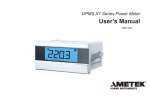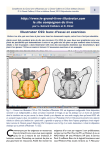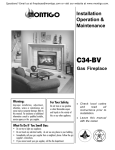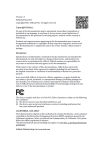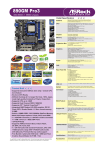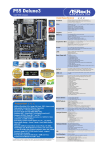Download DuraVent Type B Troubleshooting guide
Transcript
MODEL DVR (ROUND) TYPE-B GAS VENT INSTALLATION INSTRUCTIONS MH6357 Read through all of these instructions before beginning your installation. Failure to install as described in these instructions will void the manufacturer’s warranty and may have an effect on your homeowner’s insurance and UL listing status. Keep these instructions for future reference. REFERENCES (1) National Fuel Gas Code, also referred to as NFPA 54 and ANSI Z223.1 (2) Simpson Dura-Vent's Sizing Handbook, available from Simpson DuraVent CONTENTS REFERENCES .......................................................................................... 1 GENERAL INFORMATION .................................................................. 1 PLANNING ............................................................................................... 2 STEPS FOR TYPICAL INSTALLATION ........................................... 4 BUCKET SUPPORT ................................................................................ 9 COMBINATION TOP ........................................................................... 10 ADJUSTABLE ELBOWS...................................................................... 11 MALE AND FEMALE ADAPTORS .................................................. 12 RELINING MASONRY CHIMNEYS .................................................. 13 MAINTENANCE .................................................................................... 19 GENERAL INFORMATION Type B Gas Vents are for venting listed Natural Gas or Liquid Propane Category I appliances only. The appliances listed below typically (but not always) use Type B vent systems. Boilers Furnaces Water Heaters Unit Heaters Room Heaters Duct Furnaces Floor Furnaces Decorative Gas Appliances Simpson Dura-Vent Type B Vent Systems may be used on other gas-burning appliances, provided the manufacturer of the appliance states in their installation instructions that Type B-vent is acceptable. Do not use Type B Vents for Category 1 II, III, or IV gas appliances. Type B Vent shall not be used to vent flue products from incinerators, combination gas/oil appliances, oil-fired, or wood-burning appliances. If there is a question about the use of Type B Vents, contact the appliance manufacturer or Simpson Dura-Vent's Engineering Department for further information. PLANNING 1. Appliances. Carefully review the appliance manufacturer's installation instructions for positioning the unit, any special venting or connector requirements, and verify that it is a Category I appliance or an appliance that requires the use of Type B gas vent. HIGH WIND TOP DuraCap TOP DOTTED LINES SHOW POSSIBLE OFFSET IN ATTIC SPACE STORM COLLAR FLASHING SEE TABLE 2 1 INCH MINIMUM CLEARANCE (ALL SIDES) FIRESTOP SPACER B-VENT ENCLOSURE 1 INCH MINIMUM CLEARANCE (ALL SIDES) CEILING SUPPORT / FIRESTOP VENT CONNECTS TO APPLIANCE Fig 1 2 2. Placement. The placement of the vent and fittings must be in accordance with Local Codes, as well as accepted venting practices. If more than one appliance is to be connected to one venting system, the common vent must be correctly sized. It is a good idea to make a sketch of the proposed installation, labelling the components you will need. Adjustable Pipe Lengths are available to make up odd lengths. Minimize the number of turns and lateral runs, as the National Fuel Gas Code places limitations on these. A 45° turn is preferable to a 90° turn. The appliance reference material should be consulted at this time, as well as any Local Authority having jurisdiction. In most localities, building permits are required for any new appliances, or modifications to existing venting systems. 3. Figures 1, 2, & 3 show examples of some typical residential installations. CEILING SUPPORT / FIRESTOP TOTAL VENT HEIGHT 90° ADJUSTABLE ELBOW B-VENT TEE B-VENT PIPE WATER HEATER CONNECTOR RISE FURNACE CONNECTOR RISE INCREASER 4. Clearance to Combustibles. A 1-inch clearance (air space) to combustible materials must be maintained, when using Simpson Dura-Vent Round BVent, regardless of the pipe diameter. WATER HEATER WITH DRAFT HOOD FAN ASSISTED FURNACE LATERAL 5. Combustion Air. Refer to appliance installation instructions and local building codes to ensure compliance with required volume of combustion air for each appliance installed . Fig 2 6. Slope. If the venting system contains lateral (horizontal) components, they shall be positioned so they have an upwards slope away from the appliance of not less than 1/4inch rise per foot of run. (Horizontal vent installed in attics, unconditioned area, or between floors have further restrictions, please consult your local building codes for specific limitations.) 7. Termination Area. Examine the area where the vent system will terminate. The height of the termination above the roof is determined by the roof pitch, and also it's proximity to adjacent walls or obstructions. Consult Table 2 on page 9 for proper termination height requirements. Vent pipe with 3"-12" diameter must terminate at least 2 feet higher than an adjacent wall or obstruction, if it 3 is within 8 feet. Vent pipe with 14" or larger diameter must terminate at least 2 feet higher than an adjacent wall or obstruction, if it is within 10 feet. 8. Connector Rise. Plan a minimum of one foot vertical connector rise coming out of each appliance. B-VENT WYE B-VENT USED AS CONNECTOR 45°/60° ADJUSTABLE ELBOW FURNACE CONNECTOR RISE 1 INCH MINIMUM TOTAL CLEARANCE VENT (ALL SIDES) HEIGHT WATER HEATER CONNECTOR RISE DURA-CONNECT FLEXIBLE SINGLE WALL CONNECTOR WATER HEATER WITH DRAFT HOOD FAN ASSISTED FURNACE LATERAL Dura-Connect installation procedures are contained in a separate instruction, obtainable from your Dura-Vent Dealer, or from Simpson Dura-Vent. The clearance to combustibles for Dura-Connect is one inch. It may not be used to pass through walls or ceilings, nor may it be placed in attics or crawl spaces. It may be used wherever single wall connector pipe is used. Fig 3 STEPS FOR TYPICAL INSTALLATION 1. Location. Building Code requires the appliance(s) to be located as close to the vent as possible. After consulting the local codes, appliance installation instructions and any other applicable reference material determine the optimum location for the appliance(s). 2. Penetration Point. Locate and mark the center of the penetration point through the ceiling or the wall. Refer to Step 3 or 4, as appropriate. 3. Ceiling Support. For a ceiling supported system, install the Square Firestop/Support as shown in Figures 6, 7, and 8. The Firestop Support must be framed in and the dimensions are shown in Table 1 and shown in Figure 4. 4 Table 1 PIPE SIZE STOCK NUMBER OF CEILING SUPPORT 3 INCH 1440 4 INCH 1441 5 INCH 1442 6 INCH 1443 7 INCH 1444 8 INCH 1445 10 INCH 1446 12 INCH 1447 EXISTING SHEET ROCK FRAMING MEMBERS REQUIRED FOR SUPPORT Fig 5 Firestop Supports are currently manufactured for FRAMED INSIDE pipe sizes of 3" through 12" DIMENSIONS (X & Y) FIG 4 only. Larger sizes may be 7-3/8" X 7-3/8" locally fabricated from sheet 7-3/8" X 7-3/8" metal, provided that the 9-1/8" X 9-1/8" mandatory 1-inch clearance 9-1/8" X 9-1/8" 11-1/8" X 11-1/8" is maintained, the pipe is 11-1/8" X 11-1/8" adequately supported, and the 13-1/8" X 13-1/8" installation is acceptable to 13-1/8" X 13-1/8" Local Authorities. In EXISTING JOISTS multistory buildings, a Firestop/ Spacer must be provided at every floor /ceiling level other than the first floor which requires a support. 4. Wall Thimble. For a throughthe-wall system, install the Wall Thimble, as shown in Figure 5. The Wall Thimble is designed to accommodate walls up to 6 inches Fig 4 thick. If you have thicker walls, a sleeve extension should be fabricated and attached to the existing sleeve . Do not fill the air space between the B-vent Pipe Section and the Wall Thimble with insulation, although an RTV-type sealant may be applied around the flange and nail heads if desired. 5. Pipe Assembly. Sections of Simpson Dura-Vent round pipe are joined together by lining up the female end of the locking lug with the male end slot, pushing them together, and turning clockwise to twist lock. Refer to Figure 9. Sheet metal screws are not needed for 3" through 5 HANGER STRAPS CLAMP AND HARDWARE HANGER STRAPS CEILNG SUPPORT Fig 7 NAILS (4 REQ) CLAMP Fig 6 8" diameter pipe. However, if desired, use 1/ 4-inch long sheet metal screws for 3" through 8" diameter pipe. Never penetrate the inner liner B-VENT with screws. For 10" through 16" diameter pipe, PIPE SECTION Simpson Dura-Vent recommends using a minimum of (4) 3/8" sheet metal screws per joint, and a minimum of (6) 3/8" sheet metal screws per PIPE COLLAR joint for 18" and larger diameters. Each Pipe (OPTIONAL) Section is labelled, and an arrow shows the direction of the exhaust flow. For ceiling supFig 8 ported installations, place a Pipe Section, or assembled Pipe Sections, through the hole in the Square Firestop Support, and tighten the Clamp. The Clamp will rest inside the Ceiling Support, and prevent the Pipe Sections from dropping down. The Pipe Section(s) should protrude a minimum of one inch below the ceiling. An optional Pipe Collar is available for decorative purposes. 6. Connectors. Only Simpson Dura-Vent connectors should be used between the appliances and the venting system. Some appliances require Type BVent as a complete dedicated system from the flue collar of the appliance to the termination of the vent to the outside atmosphere. Simpson Dura-Vent’s listed flexible, single-wall corrugated aluminum connector, called “Dura-Connect” can 6 be used in many applications when a B-Vent connector is not required. 7. Elbows. When Elbows are required, strap the Pipe Sections and/or Elbows in place using Wall Straps. Support the offset so that the weight of the offsetting pipe is not bearing down on the elbows, as shown in Figure 10. STEP 2 STEP 3 8. Tees and Wyes. Tees and Wyes are used to combine connectors from 2 or more appliances into a common vent as shown in Figures 2 and 3. A Tee Fig 9 STEP 1 should be used in a through-the-wall application, (Figure 11), as they have a removable Tee Cap (available as a separate item) attached to the bottom. This Tee Cap may be removed in order to inspect the system, or to clean out debris or collected condensate from the common vent. Wall Straps should be used to support the vertical pipe as needed to provide a secure installation. Wall Straps every four feet are recommended. 9. Enclosures. Any portion of the vent which passes through an occupied area must be enclosed, to prevent accidental damage to the system, as well as burns. Figure 1 (page 2) shows a system which passes through an occupied second floor. Simpson DuraFig 10 Vent does not recommend installation of B-Vent Pipe on the outside wall of a building, particularly in cold climates. If it is necessary to do this, WALL STRAPS enclose the outside portion of the sysEXISTING STRUCTURE tem in a chase, as shown in Figure 11. 1 INCH It would be wise to consult the Local MINIMUM CLEARANCE TO Authority prior to construction. Note COMBUSTIBLES AT ALL POINTS that the enclosure requires an access 45/60° ELBOW door for inspection and maintenance purposes. WALL STRAP 10. Terminations. Where the Pipe ELBOW GORES Sections pass through the roof, a hole must be cut to provide a minimum CEILING SUPPORT 7 clearance (air space) of 1 inch between the Pipe and construction materials. Straight lengths of pipe are run up above the roof. (see table 2) A Roof Flashing is placed down over the pipe, and adjusted so it fits tightly against the roof, with the Pipe Section held in a position maintaining the 1 inch minimum clearance from combustibles. The Flashing is then nailed to the roof. The roofing material (shingles, asphalt paper, etc.) should overlap the top edge (uphill side) of the Flashing. A non-hardening sealant should be used around the edges of the flashing base where it meets the roof, as shown in Figure 12. Non-hardening sealant is placed around the joint between the Flashing and the vertical Pipe Section and the Storm Collar is then placed over this joint, to make a watertight seal. Add sufficient Pipe Sections to attain the height specified in Table 2. To connect the Top to the pipe, hold Top by its collar, slide collar over locking lugs of pipe, and twist-lock clockwise. Tops of diameters greater than 16 inches do not twist-lock, but are affixed with sheet metal screws. 11. Inspection. This com- 1 INCH MINIMUM CLEARANCE (ALL SIDES) WALL STRAP FRAMED ENCLOSURE WALL THIMBLE WALL STRAP REMOVABLE ACCESS DOOR/PANEL FOR CLEANNG AND INSPECTION GAS APPLIANCE TEE TEE CAP Fig 11 TOPS ARE INTERCHANGEABLE HIGH WIND TOP DuraCap TOP SEALANT SEE TABLE 2 Fig 12 8 STORM COLLAR FLASHING 1 INCH MINIMUM CLEARANCE 1 INCH MINIMUM CLEARANCE pletes the installation steps. Conduct a final inspection to insure that all joints are secure, the system is properly supported, and is mechanically sound. Especially verify that the one-inch clearance to combustibles requirement has been met, and that adequate combustion air will be furnished to the appliance. GAS VENT SYSTEMS USING VENT CAPS LISTED BY UNDERWRITER’S LABORATORIES MAY TERMINATE IN ACCORDANCE WITH THIS VENT TERMINATION TABLE ROOF PITCH MINIMUM HEIGHT FEET METERS FLAT TO 7/12 1 0.3 OVER 7/12 TO 8/12 1.5 0.46 OVER 8/12 TO 9/12 2 0.61 OVER 9/12 TO 10/12 2.5 0.76 OVER 10/12 TO 11/12 3.25 0.99 OVER 11/12 TO 12/12 4 1.22 OVER 12/12 TO 14/12 5 1.52 OVER 14/12 TO 16/12 6 1.83 OVER 16/12 TO 18/12 7 2.13 OVER 18/12 TO 20/12 7.5 2.29 OVER 20/12 TO 21/12 8 2.44 BUCKET SUPPORT Table 2 1. Description. The Bucket Support (shown in Figure 13) is for properly supporting the B-vent between 16 or 24-inch O.C. joists or rafters, or for providing a transition fitting beCONTINUATION tween OF B-VENT SYSTEM DuraConFig 13 B-VENT nect Single Wall Connector and the B-vent Pipe BUCKET SUPPORT Sections. A maximum of 20 feet of Type B RAFTER 16 OR 24 INCHES O.C. Gas Vent may be supported. Note that the NAIL HERE Bucket Support must be installed prior to the sheetrock. 2. Assembly. After you have determined where the B-vent should be located, assemble the Bucket Support and BrackCEILING ets. Nail the assembly to the bottom side of the joist material as shown in Figure 14. SINGLE-WALL CONNECTOR After the Support Bucket is in place, scribe (DURA-CONNECT) and cut out a hole in the sheet rock 1/8" Fig 14 larger than the diameter of the Bucket, and 9 nail into place. Run the Pipe Sections through the hole in the Bucket Support, connect the Dura-Connect Single Wall Connector, and attach the Clamp so that it rests inside the Bucket, and will support the Pipe. Adjust the Pipe to the desired height and tighten the Clamp. This will provide a complete engineered support system. 1-1/2 TO 3 INCHES COMBINATION TOP 1. Description. The Combination Top, provides an easily installed, safe and efficient B-Vent Top and Flashing, as one lightweight unit. The two basic components and the assembled unit are shown in Figure 15. The Combination Top is designed to accommodate roof pitches from flat to 6/12, and is available for 3" through 6" diameter B-Vent pipe. 2. Location. Locate the point in the underside of the roof where the system is to penetrate, using a plumb bob or level. 3. Hole. Remove sufficient roofing material to cut a hole in the roof which 1" MINIMUM Fig 16 Fig 15 APPLY SEALANT ALONG TOP, LEFT, AND RIGHT EDGES, AND ON NAIL HEADS Fig 17 will allow a minimum of 1 inch air space between the B-Vent and combustible roofing materials. 4. Flashing. Position the Flashing so the hole is directly over the end of the pipe, as shown in Figure 16. Run the top edge of the Flashing under the roof covering, nail as required, 10 AND THEN FOLD THEM OVER TO HOLD CONE TO FLASHING RUN TABS ON FLASHING UP THRU RAISED SLOTS ON CONE Fig 18 and seal with a non-hardening sealant, as shown in Figure 17. Seal all nail heads. 5. Height. Add sufficient Pipe Sections of B-Vent until the system terminates 1-1/2" to 3" above the collar of the Flashing as shown in Figure 16. 6. Top Cone. Slip the Top Cone over the Flashing, so the vertical straps on the Flashing coincide with the slots at the base of the Cone. Slip the straps up through the slots as shown in SHEET Figure 18. Adjust the Top Cone to METAL SCREW 1/43/8" a generally vertical position. INCH LONG Holding the Top Cone in position, bend the straps down as shown. 7. This completes the installation. Conduct a final inspection of the job to insure proper joints, correct procedures, DRILL 1/8" sealed nail heads, etc. DIAMETER HOLE. DO NOT PENETRATE INNER LINER. Fig 19 ADJUSTABLE ELBOWS 1. Purpose. This section furnishes supplemental information concerning Adjustable Elbows, both 90° and 45°/60°. 2. Connections. In addition to twist locking the elbows, the connection may be further secured by using sheet metal screws at the joint where the male and female parts overlap, provided that the screws do not penetrate the inner liner as shown in Figure 19. One screw per joint is normally sufficient. Use #8 Pan Head sheet metal screws which are no longer than 1/4 inch. Liberal use of Wall Straps for additional support is recommended. Do not allow the weight of the offsetting pipe to bear down on lower elbow. 3. 90° Elbows. Figure 20. The installer should apply pressure to the section at the points indicated by the arrows. This will prevent the adjacent sections of the elbow from turning, as the next pipe or fitting is twist-locked on. This is important, because once these sections start rotating, the elbow Fig 20 11 MALE FEMALE 10° DISPLACEMENT Fig 21 does no longer have a 90° angle. 4. 45° Offsets with 90° Elbows. Figure 21 shows a 90° Adjustable Elbow being utilized to accomplish a 45° offset. This Elbow is completely adjustable from 0° to 90°. Please note that the centers of the upper sections tend to displace by a slight amount, as they are rotated. Again, screws (not longer than 1/4") may be used to secure the joint. Wall Straps should also be utilized to enhance the stability of the vent system. MALE AND FEMALE ADAPTORS 1. Description. The male and female adaptors enable an installer to connect Simpson Dura-Vent BB-VENT vent components to an existing Type B gas vent system ADAPTOR (FEMALE) manufactured by the following companies: American Metals Products, Household Mfg, Hart & Cooley Mfg, Metal Fab, Inc, White Metal Products, Air Jet, Mitchell Metal Products. Fig 22 2. Connecting into Existing Competitors System. To connect into an existing competitors gas venting system from below, or from the appliance side, connect B-VENT ADAPTOR a Female Adaptor as shown in Figure 22, insuring that (MALE) the inner liner of the adaptor is outside the inner liner of the existing pipe. Push the adaptor as far up as it will go, and tighten the locking bolt until the connection is snug. 3. Extending an Existing Competitors System. To continue an existing competitors system up towards EXISTING SYSTEM the termination using Dura-Vent Type B Gas Vent, Fig 23 connect a Male Adaptor to the last section of the system, as shown in Figure 23, insuring that the inner liner of the Adaptor fits smoothly inside the Pipe or fitting below it. Push the Adaptor down as far as it will go, and tighten the locking bolt until the connection is snug. EXISTING SYSTEM 12 RELINING MASONRY CHIMNEYS FOR USE WITH GAS APPLIANCES 1. Description. A masonry chimney should be relined with B-Vent when venting a Category I gas appliance, such as a gas fireplace insert or freestanding gas stove, or to improve the venting and reduce condensation of existing gas appliances which are currently venting into the masonry chimney. These instructions encompass two general configurations: (1) A gas fireplace situated inside an existing masonry fireplace (Figure 24) or (2), a free- GAS RELINING ASSEMBLY B-VENT PIPE SECTIONS EXISTING MASONRY FIREPLACE AND CHIMNEY FLEX PIPE GAS FIREPLACE Fig 24 B C 12 INCHES A Fig 25 standing gas appliance venting into an existing masonry chimney. (Figure 30) 2. Masonry Inspection. Have the masonry chimney inspected by a qualified chimney sweep or installer to determine it's structural condition. Clean and repair as necessary. 3. Gas Fireplace. Carefully read the appliance manufacturer's installation instructions. Use the recommended vent size. Do not reduce the vent size below that of the flue exit on the appliance. Do not common vent gas fireplaces. (a) Measurements. Measure and record the dimension as shown on Figure 25 (Height "A"). You will need an additional 12" of vent above the masonry chimney. It is a good idea to allow for a little extra height 13 DRAFT HOOD CONNECTOR Fig 26 in your measurements. (b) Pipe and Fitting Requirements. The bottom 5 foot section of vent will be Flex Pipe (used to get around the smoke shelf, and to connect to the appliance). The remainder will be rigid B-Vent Pipe Sections. For each pipe Fig 27 joint, subtract 1-1/2 inches. (c). Connector. Read the appliance manufacturer's instructions for connecting the Flex Pipe to the appliance. In most cases, a Draft Hood Connector will be required as shown in Figure 26. If you are not sure, contact the appliance manufacturer for clarification. Place the appliance out in front of the fireplace area, as shown in Figure 27, and install the Draft Hood Connector, or other device in accordance with the appliance instructions. The APPLY Flex Pipe Coupling may be able to NON-HARDENING SEALANT GAS RELINING attach directly to the appliance. TERMINATION ASSEMBLY (d). Flex Pipe Assembly. Assemble first Rigid Pipe Section to the Flex Pipe, insuring that the "UP" arrows are in fact, pointing up. Push the sections together and twist MASONRY ANCHORS to lock. Screws are not required, however if you desire to use them, use #8 sheet metal screws 1/4-inch long, being careful not to penetrate the inner liner. Repeat this process TRIM BASE TO FIT for the remainder of the Pipe SecMASONRY tions, and lower the assembly down the chimney. Lower it below it's normal position as shown in Figure 28. Fig 28 NON-HARDENING SEALANT (e). Position and Connect 14 BASE OF GAS Fireplace. Push the gas fireplace towards the MASONRY RELINING ANCHORS TERMINATION firebox, and connect the Flex Pipe female couASSEMBLY TRIMMED AND pling to the appliance, or to the appropriate SHAPED TO FIT MASONRY AND connector as specified by the appliance manuFLUE TILE facturer. If insufficient space is available between the top of the appliance, and the fireplace APPLY NONHARDENING opening, an access opening in the opposite side SEALANT AROUND THESE SURFACES of the masonry chimney may be necessary. Position the gas appliance on it's final location, again complying with the manufacturer's inFig 29 structions in regards to location. Install any shields or covers at this time. (f). Adjust Height. Go to the top of the chimney and pull the vent system up to its desired height. In most cases, this will be 12 inches above the masonry surface. Make a mark on the Pipe Section even with the top of the masonry surface. If the top of the pipe is near a steep roof (more than 7/12 pitch) ,use the height as stated in Table 2. (g). Termination Assembly. Trim the Base Plate of the Termination Assembly to cover the masonry opening. Refer to Figures 28 and 29. Slip the Base down over the protruding Pipe Section. Use masonry anchors and nonhardening sealant to secure the Base to the masonry. (h). Clamp. Pull the Pipe up through the Base to the mark, which you previously made. Slip the Clamp down to the mark, and tighten it securely to the Pipe. The Clamp will then support the entire venting system. Slip the Storm Collar down over the Pipe Section, and seal the joint with a non-hardening sealant. (i). Top. Install the Top, as shown in Figure 28. This concludes the procedures for installing a gas fireplace in an existing masonry fireplace. Conduct a final inspection of the system, and verify that the manufacturer's installation instructions have been totally complied with. 2. Gas Appliance Venting Into the Side Wall of a Masonry Chimney. (a). Locate Appliance. Set the appliance in it's desired position, and mark the center of the hole where the lateral Pipe Section is to pierce the masonry chimney. Insure the manufacturer's requirements are complied with, particularly in regards to distances from combustible surfaces. Refer to Figure 30. (b). Hole in Masonry. Move the appliance aside, and break out the masonry, forming a hole large enough for the Pipe Section to get through, and also 15 large enough to reach through and hold the Tee, while connecting the horizontal Pipe Section. An alternate procedure is to make the hole only large enough for the Pipe Section to pass through, and construct an access gate on the other side of the masonry chimney. Do not mortar to the pipe. . (c). Tee. A Tee is installed at the bottom end of the assembled vertical Pipe Sections, as shown in Figure 30. The Tee has a removable Tee Cap at the bottom, for cleaning and condensate removal. If the configuration of the building permits it, a clean-out access gate is recommended. (d). Vertical Pipe Sections. Run the assembled vertical Pipe Sections (with the Tee attached to the bottom), down the chimney, until the horizontal branch of the Tee is opposite the hole in the masonry. (e). Adjust Height. Hold the assembled Pipe Sections in this position, and make a mark even with the top surface of the masonry chimney. The vertical Pipe Sections should protrude 12 inches (in most cases) above this mark. If the top of the pipe will be near a steep roof (more than 7/12 pitch), use the height as stated in Table 2. (f). Termination Assembly. Trim the Base Plate of the Termination Assembly to cover the masonry opening. Refer to Figures 28 and 29. Slip the Base down over the protruding Pipe Section. If necessary, use masonry anchors and non-hardening sealant to secure the Base to the masonry or bend base to secure. (g). Clamp. Pull the Pipe up GAS RELINING TERMINATION through the Base to the mark, which you ASSEMBLY made previously. Slip the Clamp down to the mark, and tighten it securely to the Pipe. The Clamp will then support the entire venting system. Slip the Storm Collar down over the Pipe Section, and seal the joint with a non-hardening TRIM COLLAR TEE high temperature RTV. (h). Horizontal Pipe Section(s). Run the horizontal Pipe DRAFT HOOD CONNECTOR Section(s) through the hole in the (IF REQUIRED) masonry, and connect it firmly to the GAS APPLIANCE Tee, either by reaching through the hole, and holding the Tee while twisting Fig 30 the Pipe Section, or by holding the Tee 16 through the access door while someone twist-locks the Pipe Section to it. Use an Adjustable Pipe Length as needed to obtain a specific location for the appliance. Make a mark on the horizontal Pipe Section flush with the vertical face of the masonry, for referencing the vertical position. Slip a Pipe Collar over the horizontal Pipe Section and install the remaining fittings as shown in Figure 30. A minimum of 12 inches of connector rise is required. (i). Insulation. Pull the Pipe Collar towards the 90° Elbow. Fill in the gap between the masonry and the horizontal Pipe Section with ceramic fiber insulation or fiberglass, as shown in Figure 31. If CERAMIC FIBER fiberglass is used, remove any paper INSULATION backing. The filling may be faced off with grout, if desired. Push the Pipe Collar back flush with the masonry. Make any final adjustments on the Adjustable Fig 31 Length Pipe (if used), and tighten the clamping bolts. TROUBLESHOOTING 1. Purpose. This section is intended as a general maintenance and troubleshooting guide, and as such, cannot encompass all configurations or vent designs. For problems encountered which are beyond the scope of this sheet, contact your Dura-Vent Dealer, Distributor, or Simpson Dura-Vent's Engineering Department. It is imperative that the one-inch clearance (air space) defined in these instructions be maintained. In most cases, a one-inch minimum clearance must be maintained to combustibles. The only exceptions are 4-inch, 5inch and 6-inch Oval B-vent which are installed within stud walls. Oval B-vent and BW Vent are the subject of a separate installation instruction, and are not discussed here. In these cases, the clearances are established by the listed Firestop Spacers described in the instructions for Oval B-Vent. 2. Appliance. Read the appliance installation instructions carefully, insuring that the prescribed clearances are met, and that it is a Category I appliance. 3. Spillage. Spillage from an appliance draft hood may cause condensation on windows, or odors that the occupant may notice. Spillage may be caused by an incorrectly sized vent system, blockage of the vent system, or a downdraft in the vent. Other causes are: excessive lateral runs, too many elbows, improper pitch to lateral runs (1/4 inch per foot of run is correct), fans or ventilation systems in the same general area as the gas appliance, or wind conditions at the 17 vent cap. 4. Blockage. Check the system for blockage by removing the cap, and looking down into the vent with a flashlight. Check for bird nests, debris, rodents, insects, or other obstructions. If nothing is found, inspect the entire system for physical damage. 5. Downdraft. Downdrafts are generally caused by the system's termination being too close to an adjacent wall, parapet, or other structure. If the cap is within eight feet of such an obstruction, it must also be at least two feet above it. Also insure that the top is at the height prescribed for your roof pitch in Table 2. Inadequate combustion air is also a major cause of downdraft problems. Appliances like clothes dryers or other exhausting appliances in the same utility room can cause downdraft problems. 6. Condensate/Corrosion. Continuous condensate can cause corrosion (rusting) of vents, tops, appliance draft hoods, and other components of the system, as well as the inside of the appliance. This situation can be extremely dangerous, and corrective action must be taken immediately. Common causes of corrosion are listed below: If in doubt call a professional to inspect the vent. (a) If the vent system is located in an area where spray cans or solvents are used extensively, (laundry areas, or paint shops, for example), the halogenated compounds get into the combustion air. When they are burned, they form compounds that cause corrosion. The corrective action in this case, is to isolate the appliance, and get the air supply from outside, or an uncontaminated area. (b) Condensate may be caused by incorrect sizing of the vent system. Follow the procedures in the various sizing publications to obtain the correct sizes for connectors and vents. Other causes are: excessive lateral runs, too many elbows, cold attics and crawl spaces, and large areas of the exterior portions of the venting system exposed to cold weather. As a general rule, laterals should be held to a minimum, and be no longer than 75% of the vertical height of the system. Condensate may initially appear as beads on the outside of the connector or vent. 7. Construction. Laterals, offsets, and vertical components should be securely supported with wall straps, as previously described. Components of the vent which are in occupied areas should be enclosed to prevent accidental contact and damage to the vent system. Insure that insulation, building materials, or debris do not extend into the required clearance spaces. In cold climates, the exterior portions of the vent should be enclosed in a chase. Outside portions of the vent system with may be painted with high temperature paint to help 18 prevent rusting and corrosion on the exterior surfaces. MAINTENANCE 1. An annual inspection is required to maintain warranty of your Simpson Dura-Vent B-Vent system. You will need to inspect the Cap, Vent Pipe, Connector Pipe, and the connection to the appliance. 2. Verify that the sealant around the Flashing and Storm Collar is intact. Reseal as needed. Remove Cap. Hold Cap by the collar only, and unlock by twisting counterclockwise, and then pull up. Grabbing the Cap by the outer edge or top can cause damage to the Cap. 3. Inspect Cap for any physical damage or damage from corrosion. Look for any foreign material inside the cap or vent. (Example: bird's nest, leaves, etc.) 4. Shine a light down inside of the vent pipe. Look for any evidence of damage, corrosion or excessive condensation. Also, look for any disconnected sections of the vent pipe or connector pipe. Refer to the installation instructions to reconnect pipe sections. If pipe sections are damaged or corroded, replace immediately! 5. Replace Cap by grabbing cap (by collar only), and slide onto pipe section and twist-locking (clockwise). 6. Inspect appliance connector and make sure that the vent is securely connected to the appliance. 7. Damaged or corroded parts should be replaced immediately! Failure to do so can lead to an extremely hazardous situation! 8. Follow your appliance manufacturer's recommended instructions for inspection your appliance. 19 Simpson Dura-Vent offers the industry’s only twenty-five year warranty on Type B gas vent system and is UL listed. This warranty is in effect from the date of installation and includes all components and fittings. Simpson Dura-Vent warrants the following products: All Fuel Class A Chimney - Dura/Plus® and Dura-Chimney®; Close Clearance Connector Pipe - DVL®; Type B Gas Vent and Pellet Vent® Chimney for a period of twenty-five years from date of installation. Warranty includes all component fittings, except rain caps, which is covered for five years from date of installation. Direct Vent GS® is warranted for ten years from the date of installation. Dura/Connect® is UL listed, approved by ICBO, BOCA and SBCCI and is warranted for ten years from the date of installation. DuraFlex® pipe and fittings is UL and ULC listed and is warranted for ten years from the date of installation. Warranty includes component fittings, except cap assembly which is covered for five years from date of installation. Dura-Black® drip free stovepipe is warranted for five years from the date of installation. Dura/Liner® is UL and ULC listed and is warranted for twenty-five years from the date of installation. All warranties, whether expressed or implied, shall be limited to replacement (exclusive of installation costs) of our product found to be defective under its warranty and shall be conditional upon compliance with the manufacturer’s recommended installation and maintenance procedures and intended use of the product, and providing all recommended installation and maintenance instructions are followed. All products must be maintained by periodic inspection and cleaning as needed, including chimney exposed to weather containing corrosive elements or contaminated intake air, due to storage of corrosive agents near the appliance. Always refer to warranty specifics for each product line. SIMPSON Dura-Vent Co., Inc. All Rights Reserved, 1998 SIMPSON DURA-VENT, INC PO Box 1510 Vacaville, CA 95688-1510 (800)-835-4429 (707)-446-4740 (FAX) April 2000 L204A Vicksburg, MS 20





















